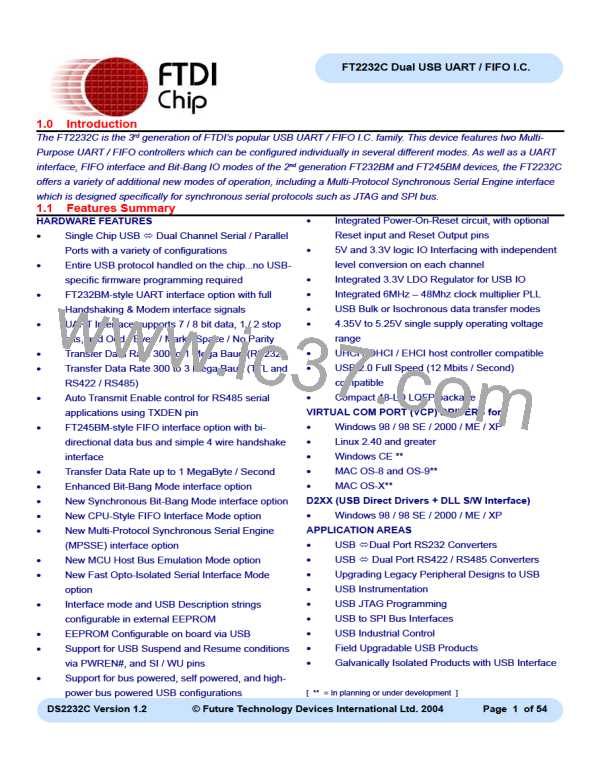FT2232C Dual USB UART / FIFO I.C.
In addition to the BM chip features, the FT2232C incorporates the following new features and interface modes :-
•
Enhanced Asynchronous Bit-Bang Interface
The FT2232C supports FTDI’s BM chip Bit Bang
mode. In Bit Bang mode, the eight FIFO data lines
can be switched between FIFO interface mode and
an 8-bit Parallel IO port. Data packets can be sent
to the device and they will be sequentially sent to
the interface at a rate controlled by an internal timer
(equivalent to the baud rate prescaler). With the
FT2232C device this mode has been enhanced
so that the internal RD# and WR# strobes are now
brought out of the device which can be used to allow
external logic to be clocked by accesses to the Bit-
Bang IO bus.
can be configured for different industry standards, or
proprietary bus protocols. For instance, it is possible
to connect one of the FT2232C’s channels to an
SRAM configurable FPGA as supplied by vendors
such as Altera and Xilinx. The FPGA device would
normally be un-configured (i.e. have no defined
function) at power-up. Application software on the PC
could use the MPSSE to download configuration data
to the FPGA over USB. This data would define the
hardware’s function on power up. The other FT2232
channel would be available for other devices.
This approach would allow a customer to create a
“generic” USB peripheral, who’s hardware function
can be defined under control of the application
software. The FPGA based hardware could be easily
upgraded or totally changed simply by changing the
FPGA configuration data file. (See FTDI’s MORPH-
IC development module for a practicle example,
www.morph-ic.com)
•
•
•
Synchronous Bit-Bang Interface
Synchronous Bit-Bang Mode differs from
Asynchronous Bit-Bang mode in that the device
is only read when it is written to. Thus making it
easier for the controlling program to measure the
response to an output stimulus as the data returned
is synchronous to the output data.
•
MCU Host Bus Emulation
This new mode combines the ‘A’ and ‘B’ bus interface
to make the FT2232C interface emulate a standard
8048 / 8051 style MCU bus. This allows peripheral
devices for these MCU families to be directly
attached to the FT2232C with IO being performed
over USB with the help of MPSSE interface
technology.
High Output Drive Level Capabillity
The IO interface pins can be made to drive out at
three times the standard drive level thus allowing
multiple devices, or devices that require a greater
drive strength to be interfaced to the FT2232C. This
option is configured in the external EEPROM, ad can
be set individually for each channel.
•
Fast Opto-Isolated Serial Interface
CPU-Style FIFO Interface
A new proprietary FTDI protocol is designed to
allow galvanically isolated devices to communicate
sychronously with the FT2232C using just 4 signal
wires (over two dual opto-isolators), and two power
lines. The peripheral circuitry controls the data
transfer rate in both directions, whilst maintaining
full data integrity. Maximum USB full speed data
rates can be acheived. Both ‘A’ and ‘B’ channels
can communicate over the same 4 wire interface if
desired.
The CPU style FIFO interface is essentially the same
function as the classic FT245 interface, however the
bus signals have been redefined to make them easier
to interface to a CPU bus.
•
Multi-Protocol Synchronous Serial Engine
Interface (M.P.S.S.E.)
The Multi-Protocol Synchronous Serial Engine
(MPSSE) interface is a new option designed to
interface efficiently with synchronous serial protocols
such as JTAG and SPI Bus. It is very flexible in that it
DS2232C Version 1.2
© Future Technology Devices International Ltd. 2004
Page 5 of 54

 FTDI [ FUTURE TECHNOLOGY DEVICES INTERNATIONAL LTD. ]
FTDI [ FUTURE TECHNOLOGY DEVICES INTERNATIONAL LTD. ]